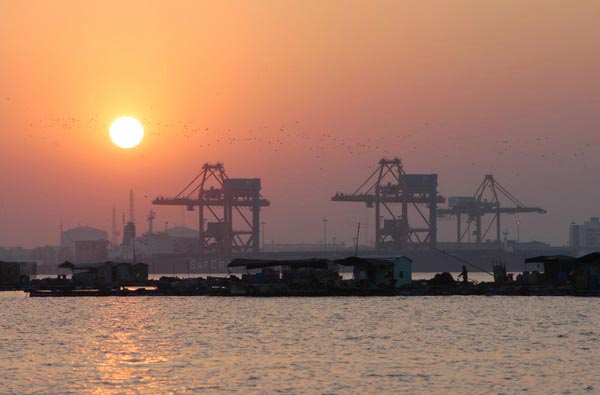Overlooking Zhanjiang port from a terrace in its iron ore terminal, one is likely to see only one clear object, a mammoth oil tanker, lying quietly on the tranquil sea, while islands appear hazily in the distance.
The transport volume of this major port on China's southwest coastline appears hazy too, at least for the first half of this year.
Liu Yonghong, deputy director of the executive office of Zhanjiang Port (Group) Co Ltd, told China Daily that in the first half of this year, the throughput of oil and iron ore, two commodities that account for more than 80 percent of the port's transport flow, dropped 9.6 percent compared with the same period last year.
|
 Sunset at Zhanjiang port in Guangdong province on Aug 18, 2012. The throughput of oil and iron ore accounts for more than 80 percent of the port's transport flow. [Photo/China Daily] |
"Because of the sluggish economic situation both at home and abroad, there is a fall in our throughput of oil and iron ore," Liu said.
The significant fall in oil, and a smaller drop in iron ore, have slashed the overall throughput of Zhanjiang port to 35.77 million deadweight tons, which is lower than the port operator's expectations.
"Our throughput in 2011 was about 80 million DWT. So we set a target of 85 million DWT for this year. But now it seems unlikely that we will achieve this goal," Liu said.
The current figure contrasted starkly with last year, when China's economy was recovering quickly after the 2009 global economic downturn.
In that year, Zhanjiang port's throughput surged by 16.7 percent, from 68.6 million DWT in 2010 to 80 million DWT in 2011.
The special shipping structure of the Zhanjiang port has made it more vulnerable to a macroeconomic slowdown.
Compared with other ports such as those in Shanghai and Ningbo, which mainly handle containers, a sign of their hinterland's robust export-oriented manufacturing industries, Zhanjiang's container business is much smaller.
Instead, raw materials such as crude oil, iron ore and coal account for the majority of the Zhanjiang port's throughput. The port has two 300,000 DWT coastal crude oil terminals, the biggest of their kind in China, and one 250,000 DWT iron ore terminal, the biggest in southern China.
The oil and iron ore that passes through these giant terminals supplies the demand of more than 20 steel plants and more than 10 petrochemical enterprises in Central and Southwest China, said Bian Yimei, vice-president of the Zhanjiang Port (Group).
Crude imports react to international crude prices. Price fluctuations and the bleak business situation of China's petrochemical enterprises have depressed demand, Liu said.
China's steel industry is also plagued by excess capacity, due to weak demand from industries such as construction. The percentage of loss-making enterprises expanded to 33.75 percent, according to China Iron and Steel Association.
Baosteel Group Corp, China's largest steel company, despite its relatively good performance this year among China's ailing steel companies, decided to halt operations at its a loading wharf in Zhanjiang.
Baosteel had planned to invest 63.5 billion yuan ($9.9 billion) to build a huge iron and steel project in Donghai Island of Zhanjiang.
As a preliminary move, a pellet-loading wharf was built in 2007. But locals said work was halted at the wharf this year, as a result of the pessimistic outlook of China's steel industry.
Zhanjiang port is not alone. Shenzhen port, which is 500 kilometers east of Zhanjiang, saw its throughput in the first half of this year increase by just 4.16 percent, and its container business edge up 1.32 percent.
Nationally, the combined container throughput of China's major ports reached 695 million TEU (twenty-foot equivalent unit containers) by the end of May, up 8.7 percent compared with the same period of last year, much lower than the 12.5 percent growth in 2011, according to the Ministry of Transportation.
Shenzhen's growth rate in container throughput ranked at the bottom among China's major ports. Zhanjiang is not listed because of its small container throughput.
"The throughput of a port is the barometer of the hinterland it covers. The economy of Shenzhen's hinterland is highly export-oriented. So the ailing global market took an immediate toll on its business," said Wang Guowen, director of Shenzhen Research Center on Logistics and Supply Chain Management.
Despite the lukewarm situation, Zhanjiang port is still planning to boost its capacity by building more new berths and terminals, given the expected surge in demand as mega projects, one by Baosteel and the other by Sinopec, are finished in the coming few years.
By the end of 2015, Zhanjiang port's total capacity will increase to 130 million DWTs and it will become a major logistics center for iron ore, oil and coal, said Liu.
zhengyangpeng@chinadaily.com.cn?
